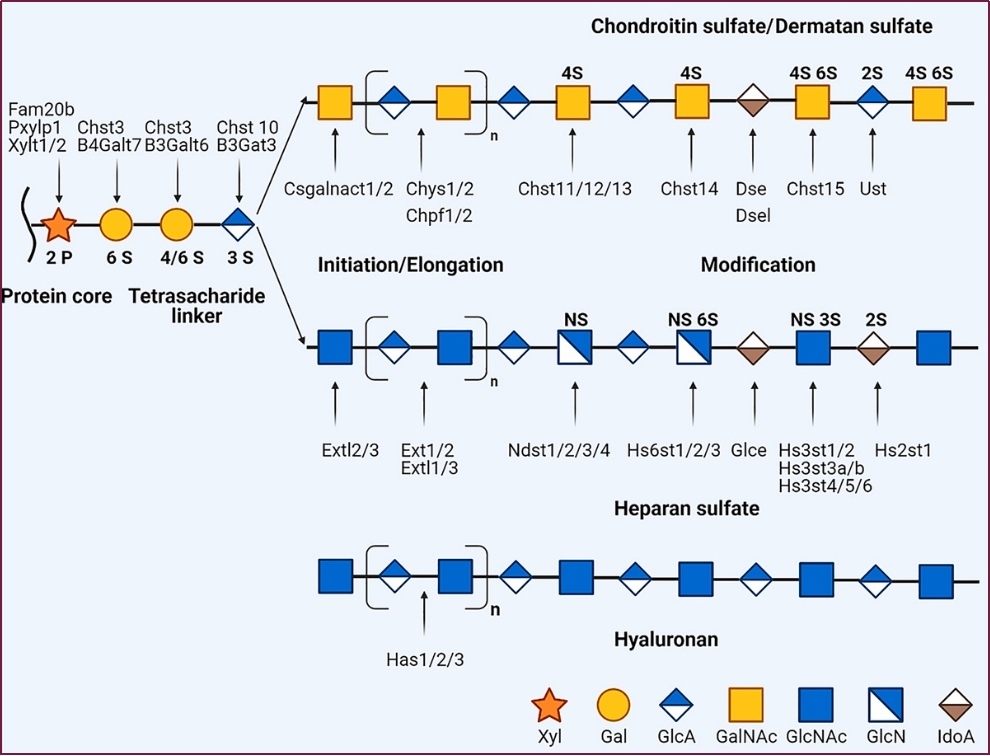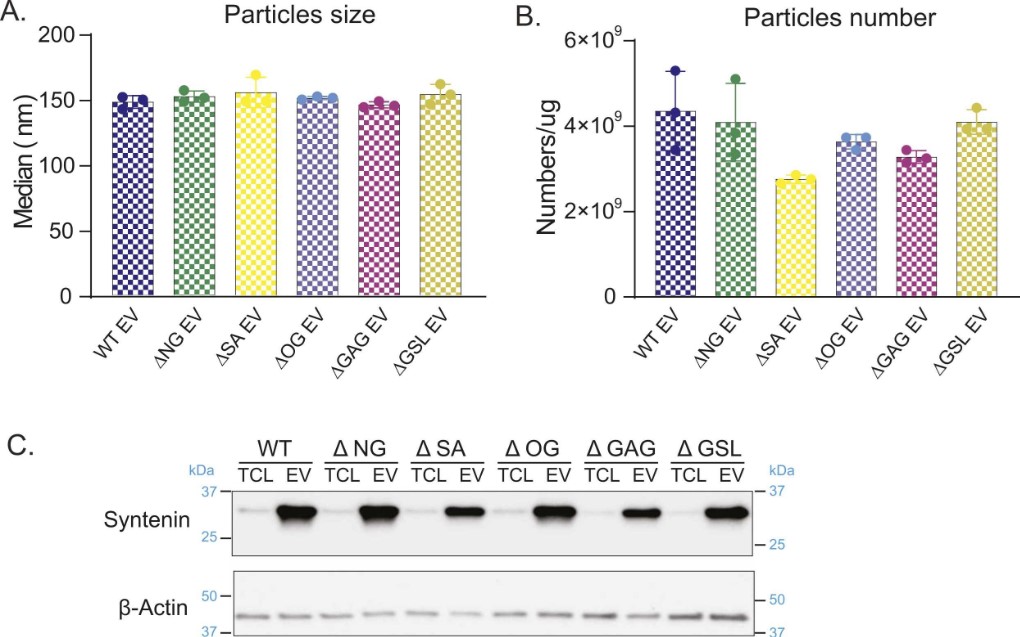Cell Glycoengineering by Manipulating Glycosaminoglycan
Biosynthesis of Glycosaminoglycan
Glycosaminoglycans (GAGs) constitute a family of structurally complex linear heteropolysaccharides that includes hyaluronan, chondroitin sulfate, dermatan sulfate, heparin, heparan sulfate, and keratan sulfate. GAGs are non-templated polysaccharides synthesized through sequential enzymatic actions. The fundamental building block of a GAG is a disaccharide. The resulting chain lengths can span from 1 to 25,000 disaccharide units following variable elongation periods. Attachments to diverse proteoglycan core proteins give rise to chains showcasing heterogeneity in terms of length, disaccharide composition, and sulfation patterns. This intricate process involves the orchestrated efforts of over 40 glycosyltransferases within the Golgi apparatus, along with epimerases, sulfotransferases, and other enzymes that collectively contribute to the intricate assembly of GAGs.
 Fig.1 Simplified biosynthesis of GAG.1, 3
Fig.1 Simplified biosynthesis of GAG.1, 3
Cell Glycoengineering by Manipulating Glycosaminoglycan at Creative Biolabs
Genetic manipulations have paved the way for the development of bioengineered GAGs with improved properties. Creative Biolabs has successfully established sophisticated platforms dedicated to providing comprehensive Genetic Glycoengineering Services. To enhance the biological activity of GAG productions, we have extensively employed genetic techniques, particularly targeted Knockin and Overexpression.
For example, through genetic modifications of CHO cells to overexpress two critical enzymes, NDST2 and 3OST1, involved in heparin biosynthesis, a remarkable increase in the secretion of GAGs into the culture medium can be achieved coupled with a significant augmentation in both di- and tri-sulfated GAGs. In addition, the introduction of CHST3 to induce 6-O-sulfation, UST to induce 2,4-O-sulfation, and CHST15 to induce 4,6-O-disulfation, may effectively expand the biosynthesis capabilities of chondroitin sulfate in CHO cells.
Our expertise extends beyond these specific methods, allowing us to address a wide range of glycoengineering needs for glycosaminoglycan.
Glycoengineering of GAGs: Applications and Benefits
GAGs fulfill a spectrum of pivotal biological functions, and extracted GAGs find diverse medical applications. Among them, heparin serves as a widely used anticoagulant in medical practices. While heparin exclusively originates from mast cells, its counterpart heparan sulfate is present in all mammalian cells. However, heparan sulfate lacks anticoagulant activity due to lower sulfation levels and a lack of antithrombin-binding pentasaccharide sequence. Given the significant medical applications and substantial demand for heparin, cell glycoengineering can be employed to produce bioengineered heparin with improved anticoagulant properties.
Features of Our Services
-
High-efficiency knockin of target gene
-
Effective overexpression vector
-
High-amount production of customized GAGs
-
Professional team of experts
Published data
Small extracellular vesicles (sEVs) range in diameter from 30 to 250 nanometers and have an important effect on communication between cells in the body. In recent years, sEVs have found broad applications in immunotherapy and regenerative medicine, and studies have shown that sEVs derived from immune cells can be used as cancer treatments. In this study, the authors proposed a method to target the glycosylation machinery of EVs through cell-based glycoengineering. The authors adjusted the elongation or biosynthesis of glycans by knocking out essential genes responsible for key glycosylation pathways in cells, such as those related to N-glycosylation, sialylation, and glycosaminoglycans. The authors then monitored and analyzed the nanoparticles of sEVs from these glycoengineered cell lines. The results showed that glycoengineering of sEVs could be effectively achieved by gene editing of cells, and provided a stable method for generating sEVs.
 Fig.2 Analysis results of glycoengineered sEVs.2, 3
Fig.2 Analysis results of glycoengineered sEVs.2, 3
GAGs play a significant role in addressing numerous human diseases, particularly in the realm of thrombosis, due to their potent anticoagulant properties. Creative Biolabs has amassed extensive experience in cell glycoengineering to generate genetically engineered GAGs with elevated yield and enhanced activity, tailored to meet the specific requirements of our clients. Please don't hesitate to contact us for more information.
References
-
Salbach-Hirsch, Juliane, et al. "New insights into the role of glycosaminoglycans in the endosteal bone microenvironment." Biological Chemistry 402.11 (2021): 1415-1425.
-
Tian, Weihua, et al. "Cell-based glycoengineering of extracellular vesicles through precise genome editing." New Biotechnology 83 (2024): 101-109.
-
Distributed under Open Access license CC BY 4.0, without modification.
For Research Use Only.
Related Services

 Fig.1 Simplified biosynthesis of GAG.1, 3
Fig.1 Simplified biosynthesis of GAG.1, 3
 Fig.2 Analysis results of glycoengineered sEVs.2, 3
Fig.2 Analysis results of glycoengineered sEVs.2, 3



